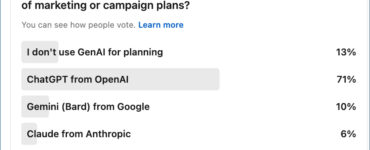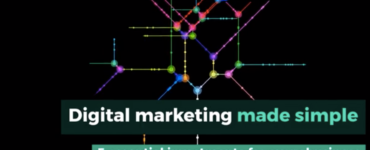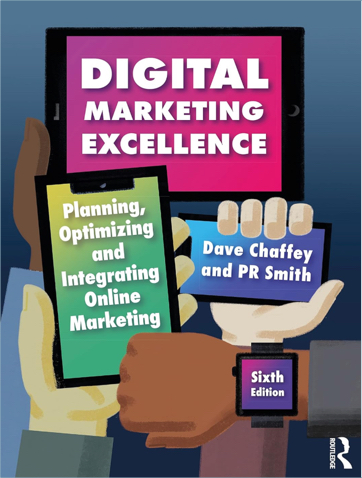Why and how I developed the RACE marketing planning framework
In the latest editions of my books on digital marketing and in our Smart Insights members resources, we feature the Smart Insights RACE planning framework for creating and managing a digital strategy. I originally developed this in 2010 since our research showed that many businesses were using digital marketing, without a strategic approach.
The idea behind the RACE marketing planning model is to provide a simple structure for companies to develop a digital marketing or omnichannel communications plan which meets the challenges of reaching and engaging online audiences to prompt conversion to online or offline sales. It is structured around the classic marketing funnel with the goals shown in this diagram.
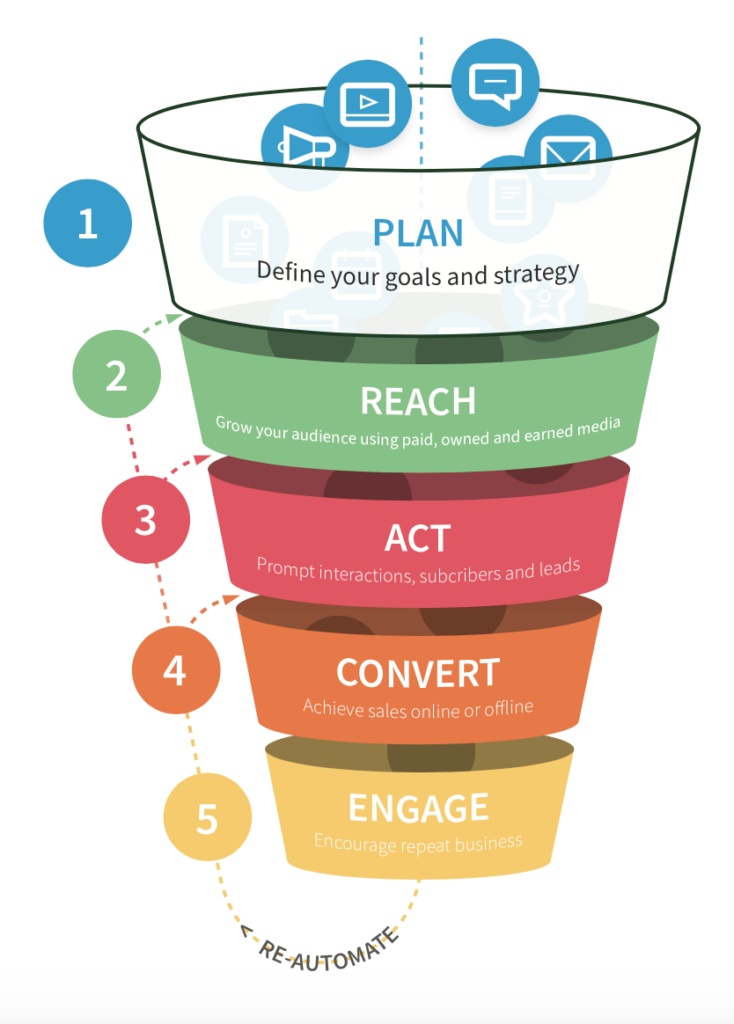
I developed RACE since, through many years of helping businesses fathom out how to adapt to the opportunities of digital marketing, I often found out that businesses didn’t have a planned, strategic approach to digital marketing. More recently, our research at Smart Insights has similarly shown that approach half of businesses didn’t have a digital marketing plan.
At the same time, I found that marketers I talked to were often keen to develop a plan for digital marketing, but were unsure where to start or how to structure it. There were also challenges of how digital marketing should be integrated with traditional communications planning since many key marketing outcomes still occur offline. RACE is often thought of as a digital marketing planning framework, but I developed it to help integrated digital marketing and traditional marketing activities. Other marketing models such as PR Smith’s strategy process framework SOSTAC® were available, but they didn’t reference the specific digital marketing activities needed to manage key digital marketing activities like search, content, website, email or content marketing.
Learn more about the RACE planning framework on SmartInsights.com
You can learn more about how to apply RACE, SOSTAC® and other models using the free Smart Insights downloads summarizing classic marketing models and digital marketing models. They were created by CIM tutor and Cranfield School of Management lecturer Annmarie Hanlon in collaboration with us to provide a free reference for students and professionals looking to apply models to businesses. Smart Insights Free membership also includes templates developed by Dave Chaffey and colleagues for creating marketing and digital marketing plans.
Free digital marketing planning templatesThis video explainer from Dave Chaffey explains the thinking behind the creation of the RACE planning framework and gives a different visualisation from the examples in this post. I also have another video explaining how to integrate SOSTAC® and RACE together.
Why use the RACE model?
Here are the reasons we recommend RACE at Smart Insights and why I think it has become popular with Smart Insights members around the world who have adopted it.
- RACE is practical and action-oriented – it focuses on tactics you can implement in your digital marketing communications and on your website and mobile apps.
- RACE is customer-centred – it follows the established customer lifecycle of relationship building or marketing funnel from creating awareness; generating leads from new prospects; converting prospects to sale online or offline and encouraging loyalty, repeat sales and advocacy such as social sharing.
- RACE integrates all modern marketing activities – RACE covers all the many paid, owned and earned inbound marketing activities available from digital marketing. Plus, it also integrates traditional offline marketing activities.
- RACE is multi-channel – many businesses still rely on offline touchpoints to acquire and retain customers, you will see these are built into RACE, particularly as part of ‘Convert’ where offline interaction is often needed to make a sale.
- RACE is commercial based on a performance improvement process – it encourages a data-driven marketing approach that defines KPIs that digital marketers should include at each stage for setting targets, reviewing results using analytics and summary dashboards and continuous optimization.
How is the RACE framework structured?
RACE consists of four steps or online marketing activities designed to help brands engage their customers throughout the customer lifecycle. There is also an initial phase of Plan involving creating the overall integrated digital strategy, objective setting and governance including resourcing up for ‘digital transformation’.
- 1. Reach: Reach is aimed at building awareness and visibility of your brand, products and services on other websites and in offline media in order to build traffic by driving visits to different web presences like your main site, microsites or social media pages. It involves maximising reach over time to create multiple interactions using different paid, owned, and earned media touchpoints. Smart use of inbound marketing techniques such as search, social media, content and email marketing are vital to get the cut through you need to drive Reach.
- 2. Act: Act is short for Interact. In the early stages when I was developing RACE, the framework was called RICE, but people I spoke to performed RACE since it was more dynamic. Unlike simpler, Reach > Convert > Retain frameworks, I defined Act as a separate stage from conversion since encouraging interactions on websites and in social media is so challenging given today’s crowded, fragmented media landscape.For most businesses, the main aim of Act is to generate online leads that can then be nurtured on the ‘path-to-purchase’. It’s about persuading site visitors or prospects to take the next step, the next Action on their customer journey when they initially reach your site or social network presence. It may mean finding out more about a company or its products, searching to find a product or reading a blog post. You should define these actions as top-level goals of the funnel in analytics. Goals can include “Viewed product”, “Added to Basket”, “Registered as member” or “Signed up for an e-newsletter”. Act is also about encouraging participation. This can be sharing of content via social media or customer reviews (strictly, part of Engage).
- 3. Convert: This stage is simply aimed at conversion to sale, either in online and/or offline channels since RACE is a multichannel or omnichannel marketing framework. It involves getting your audience to take that vital next step which turns them into paying customers whether the payment is taken through online e-commerce transactions or offline channels.
- 4. Engage: Aimed at long-term customer engagement and communications that is, developing a long-term relationship with first-time buyers to build customer loyalty as repeat purchases using communications on your site, social presence, email and direct interactions to boost customer lifetime value. It can be measured by repeat actions such as repeat sale and sharing content through social media. We also need to measure the percentage of active customers (or email subscribers) and customer satisfaction and recommendation using other systems.
To summarise RACE Dan Bosomworth, our marketing director at the time and co-founder of the agency First10 created what has become a popular infographic structured around RACE in 2012 and I updated it in 2015 as shown below. It shows the Key measures to set targets for and evaluate at each stage of the funnel.
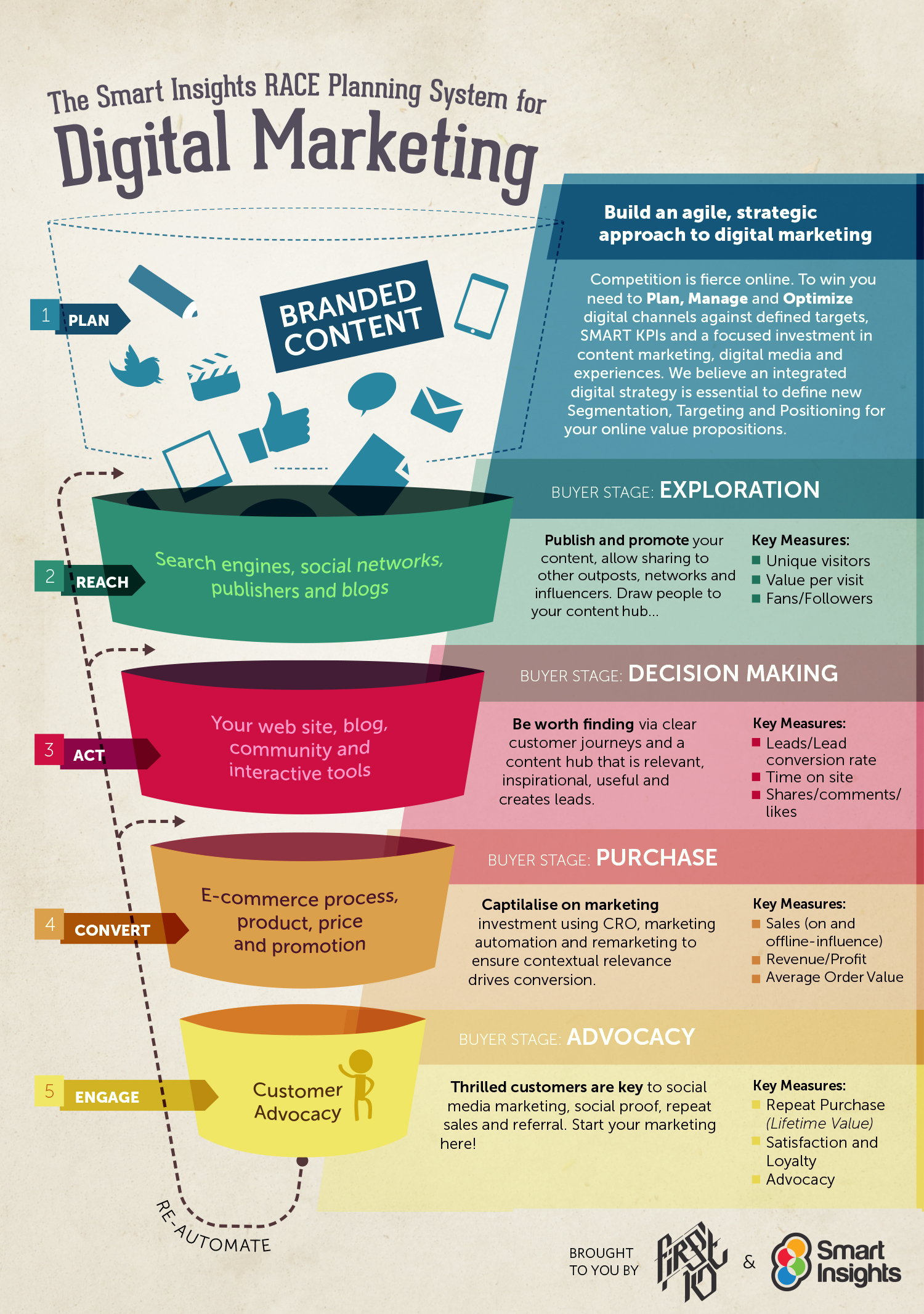
RACE is an omnichannel marketing framework
Although RACE is often cited as a digital marketing framework and it was indeed developed to emphasize the importance of digital marketing interactions RACE and create integrated digital plans, it has always been aimed at managing both online AND offline marketing communications to increase sales through digital AND traditional channels.
It’s designed to manage the integration of digital and traditional communications which is a major challenge of marketing today. The Convert stage involves planning both online and offline communications to promote sales either through digital channels and/or physical channels since this form of multichannel marketing is still an important approach in many sectors. This means that it can be applied to all sectors including B2B services and is not restricted to retail e-commerce applications.
Learn more about detailed activities to manage within RACE
To make RACE actionable within real-world digital marketing activities or ‘Marketing Jobs-to-be-Done’, within our Smart Insights members resources, such as our e-learning, we break down RACE further into 25 key digital communications activities to manage for most types of business, regardless of their size or sector. There are five key activities for each part of RACE.
Visit our dedicated page on Smart Insights to find out more applying the RACE Planning Framework including a free downloadable template explaining more about the activities at each stage and our RACE digital marketing dashboard for performance reporting based on Google Analytics goals.
We also have an Essential guide explaining how to use RACE to create a digital marketing plan for small businesses.
You can learn more about how to apply RACE, SOSTAC(R) and other models in our free downloads summarizing classic marketing models and digital marketing models.
I also like to credit the REAN (Reach > Engage > Activate > Nurture) framework for web analysts which influenced my thinking back in 2010. It was originally developed by Xavier Blanc and popularised by Steve Jackson in his book Cult of Analytics of which I’m a big fan.

